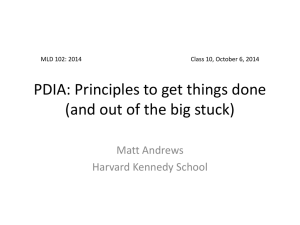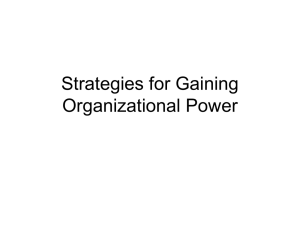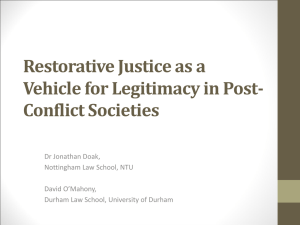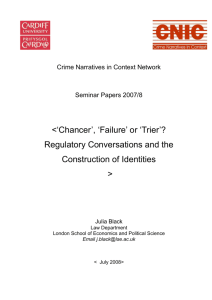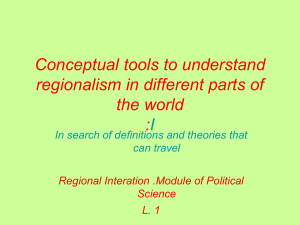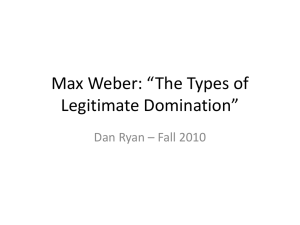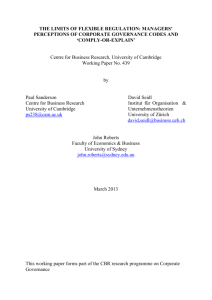Reflexive governance or legitimation of noncompliance? Applying
advertisement
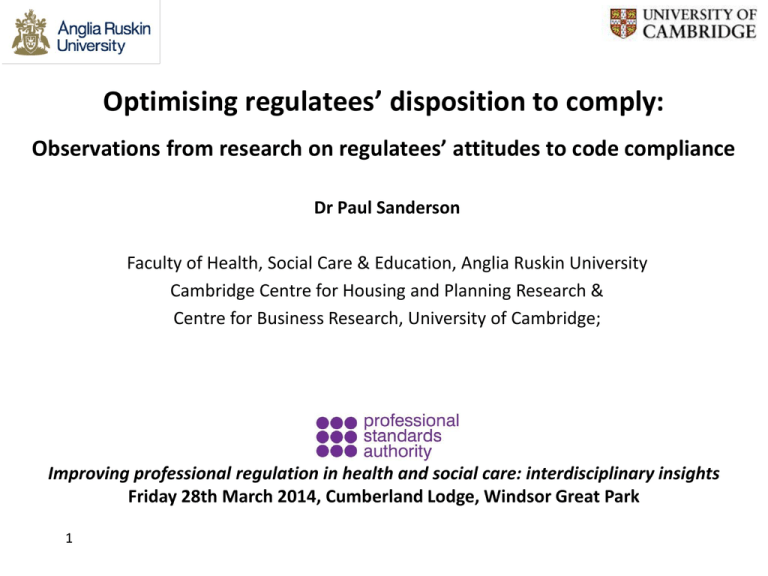
Optimising regulatees’ disposition to comply: Observations from research on regulatees’ attitudes to code compliance Dr Paul Sanderson Faculty of Health, Social Care & Education, Anglia Ruskin University Cambridge Centre for Housing and Planning Research & Centre for Business Research, University of Cambridge; Improving professional regulation in health and social care: interdisciplinary insights Friday 28th March 2014, Cumberland Lodge, Windsor Great Park 1 Why persuade regulatees to comply? (1) License revoked License suspension after all…. regulatory resource cost probably diminishes Criminal penalty Civil penalty Warning letter Persuasion (information, guidance, voluntary codes, etc.) Proportionate Enforcement Pyramid from Responsive Regulation (Ayres & Braithwaite 1992) … but regulatory efficiency (precision) and innovation also diminish Persuasion and the ‘Benign Big Gun’ (Ayres and Braithwaite 1992) 3 Why persuade regulatees to comply? (2) License revoked License suspend Criminal penalty Externalised costs from inefficient regulation Civil penalty Warning letter Space for Innovation Persuasion (information, guidance, voluntary codes, etc.) Proportionate Enforcement, Externalised Costs and Innovation Pyramids drawing on Responsive Regulation (Ayres & Braithwaite 1992) If innovation is to be encouraged, what is the conceptual role then for the regulator? 5 PURPOSE OF REGULATION: TO OPTIMISE THE QUALITY & QUANTITY OF GOODS & SERVICES TO THE PUBLIC Sanderson, (2011) The Citizen in Regulation. Birmingham: Local Better Regulation Office. From a research perspective, some questions: Given the potential optimality of ‘persuasion’ ….. Q When do more discursive, behaviour-shaping regulatory forms such as persuasion (information provision, guidance, voluntary codes etc.) work and when do they not, or … Q In what circumstances are regulatees likely to respond positively to persuasion …. so …. Q What determines whether regulatees view regulatory strategy as consistent with their values and beliefs, i.e. ‘legitimate,’ and therefore have an increased propensity to comply? 6 ….. And ……Q. Why focus on legitimacy? Why are perceptions of the legitimacy of regulation important? A. Stakeholder salience theory Power of regulator to affect profits, sustainability etc. of regulatee (e.g. benign big gun) Urgency of approach is a function of relevance of regulatory issue to regulatee (entirely contingent e.g. on media) Legitimacy: ‘generalized perception or assumption that the actions of an entity are desirable, proper, or appropriate within some socially constructed system of norms, values, beliefs, and definitions’ (Suchman 1995: 574). Mitchell, Agle, and Wood, (1997) Legitimacy • “a generalized perception or assumption that the actions of an entity are desirable, proper, or appropriate within some socially constructed system of norms, values, beliefs, and definitions” (Suchman 1995: 574) • “Organizations seek to establish congruence between the social values associated with or implied by their activities and the norms of acceptable behaviour in the larger social system in which they are a part. In so far as these two value systems are congruent we can speak of organizational legitimacy. When an actual or potential disparity exists between the two value systems there will exist a threat to organizational legitimacy” (Mathews 1993). 8 Forms of legitimacy …. and regulation • Moral legitimacy, bestowed on actions which promote the most cherished values, norms and beliefs of a society (Suchman 1995). For companies the moral legitimacy of a code depends upon their perceptions of the rightness of the outcomes of compliance. A typical example could be whether a regulatory code is perceived to embody best practice; • Pragmatic legitimacy, arises from a specific private benefit being accorded (Suchman 1995), e.g. compliance with a regulatory code may lower the cost of capital for a company • Cognitive legitimacy, (Suchman 1995), regulators/regulatees draw on the same knowledge and so understand and empathize with each other, reinforced over time, ‘taken-for-grantedness’, e.g. the form of regulatory intervention is perceived to be correct – there is no alternative – one-size-fits-all type of law may be sub-optimal but equally lack of sectoral regulation advantages competitors who spend less on customer service. 9 Empirical research on voluntaristic corporate governance codes to examine regulatory legitimacy • Project: – Soft Regulation? Conforming with the Principle of 'Comply or Explain,' ESRC (RES-000-23-1501) • Comparative research – UK: common law, liberalism (self regulation tradition), equity finance, dispersed shareholdings with concentrated institutional control. – Germany: civil law, corporatism, bank finance, family blockholdings but similar codes of corporate governance, i.e. similar regulatory regimes • Data – Analyse 260 companies Corporate governance statements – Interviews with directors, CG managers, legal counsel etc. 10 Why are corporate governance codes and complyor-explain of particular interest? • Ultimate in persuasive regulation: – noncompliance = compliance • Either: – demonstrate direct compliance with a rule (and underlying principle) or; – explain rule noncompliance (non-conformance) by demonstrating compliance with the underlying principle or; – explain why compliance with a rule (and possibly even the underlying principle) is not possible or is not desirable, i.e. not in the interests of stakeholders. 11 Moral legitimacy: (best practice – the right thing to do, UK>G) • “In many ways the Code came about from experienced City operators collaborating over what were the sort of elements that made companies operate well and effectively, […] So it was built out of current best practice as opposed to being driven by a particularly political agenda or some other element extraneous to business itself. It came from within rather than from outside.” (U) • “[The Code is] … absolute, without democratic control, without any feedback from companies ... by some professors of whom you don't know whether they ever have seen a company from the inside.” (G majority) 12 Creating a disposition to comply: Message 1: • Rules should embody best practice … • … which requires regulatee participation in: – – – – Formation Development Evaluation Revision ………. of rules, which will engender a • Sense of ownership of the regulations 13 Pragmatic (private benefits): G>UK • “A few years ago there were a plethora of codes coming out and every major institutional shareholder felt that it ought to have its own statement of principles or code and therefore measure the report against that. So you would end up with a pile of codes and you would say, well, they are all trying to get to the same place” (U) • “This corporate governance code is a bureaucratic monster. The only good aspect […] is that it explains very well the corporate legal structure of German publicly listed companies, […] something like corporate law and German employees' participation for dummies. They achieved this and it is something worthwhile in order not to have to take on board every idiocy from the Anglo-Saxons, such as the one tier board structure.” (G) 14 Creating a disposition to comply: Message 2 • Identify (perhaps explore with regulatees) the private benefits of compliance – Lower cost of capital (e.g. HAs) – Lower transaction costs (single regulatory code cf. network regulation) – Some forms of regulation can lower risk of non-compliance and associated costs (e.g. Primary Authority) 15 Cognitive: “taken-for-grantedness”: the regulatory style (e.g. voluntaristic code) is the only way to rule: (UK>>>G) • “I think the [UK] Code has been very successful, from a number of perspectives I think. Perhaps at the outset it was looked on as being the standard to aspire towards but now I think it is very much more looked on as being a framework and, if you like, in some sense a minimum that people then operate to.” (U) • “The fact is that if the lawmakers want something done they should make a law – they do anyway - there is enough law around. And if they do not want this, they should stay clear of it. But these recommendations – 'should', 'could' – what do I get out of it? Nothing!” [ … ] Either there is law or 16 there is no law.” (G) Creating a disposition to comply: Message 3 • Fit the regulatory regime/style/approach to regulatee practice, perceptions and culture. – e.g. continually review regulation strategy for alignment with best practice and private benefits – e.g. use the language of regulatees to optimise communication. 17 Corporate Governance Findings • Legitimacy was questioned more in Germany than UK but some regulatees simply need to be introduced to the benign big gun!: – “I am impressed by Mr Wiedeking. I like the way he resists complying with the rules. I do not think Mr Cromme (CG Code Commission chair) is completely honest. You just have to look at what happened with Volkswagen. There is no mention in the code that the board is not allowed to visit a brothel with the employees’ representatives!”(G) • Overall findings surprising? Germany = stakeholder/corporatism; UK = shareholder/neo-liberal influenced which includes self-regulatory tradition. • UK companies: – understood form of reuglation – were involved in creation of regulation – some private benefits • German companies: – mainly private benefits (which is not enough to create an overwhelming disposition to comply) 18 General conclusion: To optimise regulatee disposition to comply, keep under review: • Rules should embody best practice • Instil a sense of ownership by engaging regulatees in regulation: • design • development • evaluation • revision • Identify to regulatees the private benefits of compliance • Use an appropriate approach/communication/form/style of regulation for regulatee practice, perceptions and culture. 19



